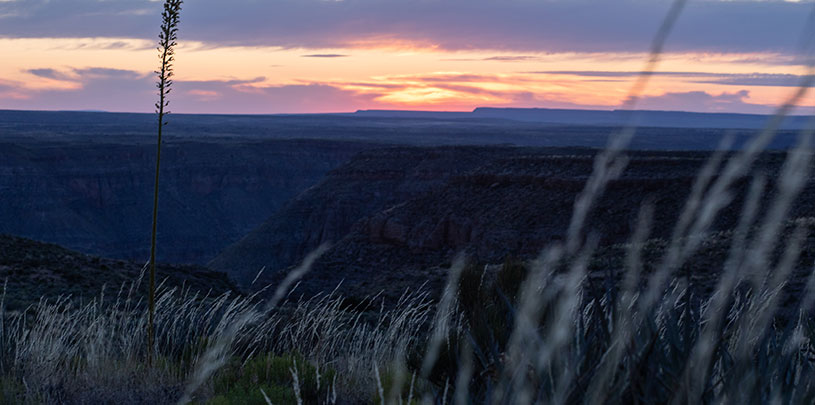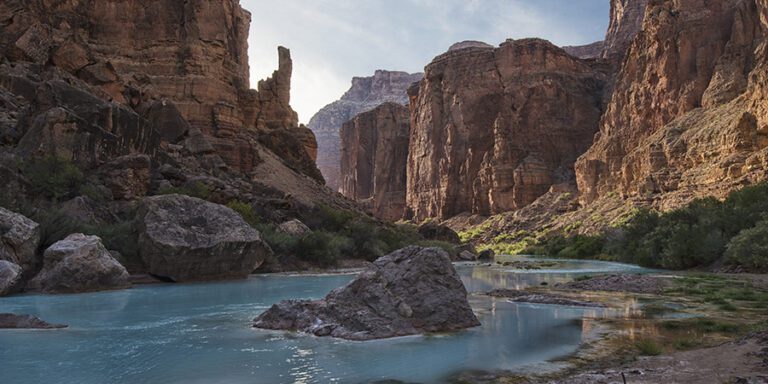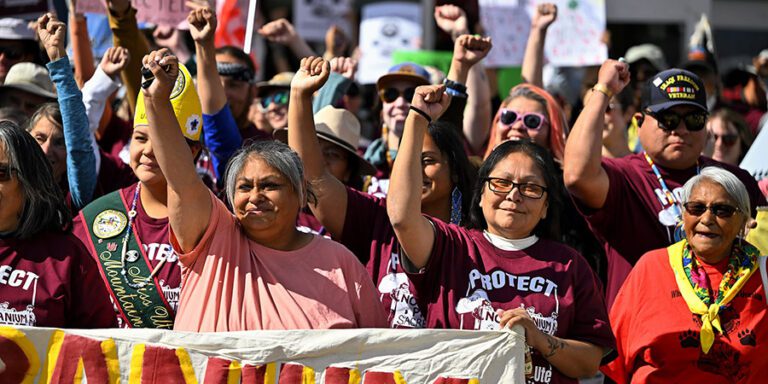
Across the monument, a permanent mining ban prevents new mining claims from being staked. But there are some exceptions.
On August 8, 2023, Native American tribes and long-time advocates for permanent protection of the Grand Canyon region saw a dream come true. With Air Force One parked on the tarmac at Grand Canyon Airport, President Biden’s motorcade rolled down Forest Service Road 305 toward a meadow near Red Butte where, within the hour, he signed a proclamation designating the Baaj Nwaavjo I’tah Kukveni – Ancestral Footprints of the Grand Canyon National Monument.
This day marked a historic achievement, not only because it established a new national monument on nearly 1 million acres of federally managed lands north and south of the Grand Canyon — only the third monument to be managed by regional tribes alongside the federal government. But this designation comes with another particularly important and long sought-after protection for the region: a permanent mining ban. Let’s look at what that really means.
A mining ban with some exceptions
When mining bans — or mineral withdrawals, as they’re technically called — are created, they have to allow for certain exceptions. Namely, under the antiquated 1872 Mining Law, a ban cannot revoke preexisting rights to mine. Doing so is considered akin to taking private property, even though these mines are on public land. Accordingly, the Grand Canyon region mining ban, just like any other, prevents any new mining claim from being staked and will prevent any existing claim from moving forward if the company hasn’t done enough work to show that the mineral deposit the claim sits atop is economically feasible to mine. But a mine that has established “valid existing rights” will be exempt.
In the Grand Canyon region, only one mine of the nearly 600 preexisting mining claims has been given this exempt status by the federal government — that’s Canyon Mine (renamed Pinyon Plain Mine by the operator, Energy Fuels Resources). The Havasupai Tribe, the Grand Canyon Trust, and others worked for years to prevent this uranium mine from gaining exempt status but lost the most recent court case in February 2022.
The White House fact sheet on the monument states there are two mines within the monument boundaries that will be allowed to go forward. It’s unclear which mine the administration views as the second — the only other uranium mine in the monument that’s still standing is the Arizona One Mine in the northwest parcel, but it stopped mining in 2014 when, according to the World Nuclear Association, “known resources were depleted.” The other possibility is Energy Fuels Resources’ EZ Complex in the northwest parcel, but it hasn’t been constructed. The Trust will continue to track the company’s activities and will take action if it moves forward, despite the permanent mining ban.
What can we expect from Canyon Mine?

Canyon Mine has been permitted since the 1980s, and the mine owner finished constructing the main shaft in 2018, but the mine has yet to start commercial production of uranium ore. Why? Because the price uranium has fetched on the market over the past four decades hasn’t been high enough for this type of mine to reel in a profit. The high energy, high-cost mining method (underground mining, which entails trucking tens of millions of pounds of rock that is over 99 percent waste to the White Mesa Mill in Utah) required to mine this particular deposit means it costs more to produce a pound of uranium from this mine than from a mine somewhere else with a different ore quality or a different mining method.
Back in 2018, a mine executive said that the mine would be viable if uranium prices climbed to $40-$50 per pound by 2019. As of October 2023, the price of uranium has climbed to $70 per pound, but so has the price of just about everything else, which likely means the mine’s break-even point is much higher than it was back in 2018. That said, activity has increased at the mine over the course of the last year, and it’s possible we’ll still see the mine kick-start production.
Do we need uranium from Canyon Mine or other Grand Canyon mines?
Nope. Very simply, the Grand Canyon region as a whole contains less than 2 percent of all unmined uranium reserves in the U.S. and the U.S.holds just 1 percent of global uranium reserves according to the World Nuclear Association. U.S. reserves are ranked 15th out of 16 countries on a list of global reserves that is led by Australia, Kazakhstan, and Canada.
Canyon Mine contains just a tiny fraction of the country’s uranium. To put it another way, Canyon Mine is expected to operate for three years and, in that time, the company expects the mine to produce up to 2.3 million pounds of uranium. For context, nuclear power plants in the U.S. use around 40 million pounds of uranium each year. That means Canyon Mine would produce less than 2 percent of the uranium the U.S. will use over the life of the mine. That’s hardly worth the risk it will create for the water of the Grand Canyon region and the new national monument itself.
What’s the fuss about uranium mining near the Grand Canyon?
Mining companies often claim that there’s “no evidence” of contamination from past mining. There’s more to that story. Research on the topic has been extremely limited due to the vast and remote geography of the region and severely underwhelming funding. This research costs tens of millions of dollars and requires frequent expeditions to remote, difficult to access locations inside the canyon where instruments are frequently blown out by flash floods or ruined by over-exposure to sunlight.

These challenges are compounded by the fact that we don’t understand groundwater systems in the region enough to know for certain where groundwater flows from mines or how fast it travels, and therefore exactly where to look for mine-caused contamination. Groundwater flow can take decades to thousands of years to emerge as surface water, much of it flowing into the Colorado River. Don’t be fooled. A lack of data does not equate to evidence that mining is safe. And in a region like the Grand Canyon where the risks of contamination are high and the possible benefit to society is miniscule, President Biden made a wise and long-needed decision when he permanently protected these lands from new mining.
The bottom line
With the exception of Canyon Mine and possibly one other unspecified mine in the northwest parcel of the monument, both of which the Grand Canyon Trust will continue to monitor, the region is safe from the threat of thousands of new uranium claims that once crowded its front door. And that, my friends, is something to celebrate.




